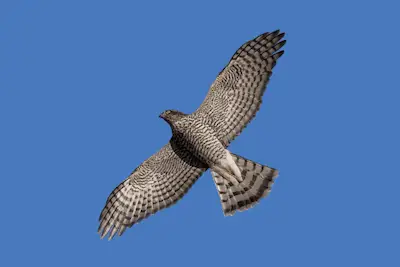Eurasian Sparrow Hawk
(Accipiter nisus)
The Eurasian Sparrowhawk (also called European Sparrowhawk) is a small raptor that feeds almost exclusively on small birds.

While originally a reclusive forest species, the Eurasian Sparrowhawk has steadily colonised cities in central, western, and northern Europe over the past decades.
This move into cities has given the Eurasian Sparrow hawk access to a rich source of sparrows and other small birds that thrive in urban areas.
Because of this, Eurasian Sparrow hawks are now a common sight in many cities, where they usually nest in parks and large gardens.
Eurasian Sparrow Hawk facts
The Eurasian Sparrow hawk is a small hawk that specializes in hunting small songbirds, and has recently managed to colonize human settlements (including large cities) in many parts of Europe.
Eurasian Sparrowhawk size
The Eurasian Sparrowhawk is a small raptor with a large size difference between males and females.
- Wingspan: 67-77 cm (females), 59-65 cm (males)
- Length: 27-38 cm
- Weight: 185-345 g (females), 110-195 g (males)
The Eurasian Sparrowhawk is similar in size and overall proportions to the Euasian Kestrel, but can be relatively easily distinguished from it due to its rounded wing tips (compared to the pointed wing tips of a kestrel).
Appearance
The overall appearance of this raptor is that of a small hawk flying rapidly and with agility around trees and other vegetation while hunting small songbirds.

Sexual dimorphism
As with most species of raptors, female Eurasian Sparrowhawks are significantly larger than males, to the extent that there is very little size overlap between the sexes. In addition to this, there is also a difference in color. While females are uniformly brown with a brown speckled underside, males are dark blue grey on top, with a light orange speckled underside.
Lifespan
A maximum age of 20 years has been documented for the Eurasian Sparrowhawk in the wild.
Scientific name and taxonomy
The scientific name of the Eurasian Sparrowhawk is Accipiter nisus. There are 3 known subspecies, all three of which occur in Europe. One subspecies is found on the Canary Island, a second on Corsica and Sardinia, and the nominate species is found throughout the rest of Europe.
Eurasian Sparrowhawk distribution
The Eurasian Sparrowhawk is found throughout Europe, with the exception of the very northernmost parts of Scandinavia, as well as Iceland. Outside of Europe, its range extends eastwards all the way to the Pacific Ocean and Japan.
Eurasian Sparrowhawk habitat
The original habitat of Eurasian Sparrowhawks were coniferous, boreal or temperate forests. However, in recent decades, it has expanded its habitat to include deciduous forests, as well as parks and even large gardens in urban areas.
Overall, the ability of the Eurasian Sparrowhawk to adapt to man-made environments has been nothing short of remarkable. Just a few decades ago, Sparrowhawk nests were almost always found on conifers (such as spruce and larch), but now the Eurasian Sparrowhawk routinely builds its nest on deciduous trees in parks, including elms, beeches, and oaks.
Due to these changes in breeding behavior, Eurasian Sparrowhawks are increasingly common in towns and cities, including the inner cities of large urban centers, where they hunt pigeons, sparrows, and other small birds.
Eurasian Sparrowhawk population size
A common raptor throughout Europe, the total population size of the Eurasian Sparrowhawk is estimated to be between 340,000 and 450,000 breeding pairs. These numbers are similar, though slightly lower, than the estimated population size of the Eurasian Kestrel in Europe.
Based on these numbers, the Eurasian Sparrowhawk is the third most common raptor in Europe, with the Common Buzzard in first place, and the Eurasian Common Kestrel in second place.
Eurasian Sparrow Hawk behavior
The most common behavior of the Eurasian Sparrow Hawk is flying stealthily at tree top height in order to surprise small passerine birds. When it spots unsuspecting prey, the Eurasian Sparrow Hawk accelerates with a quick sprint, and attempts to take its prey close to the ground.
The Eurasian Sparrow Hawk also hunts from a perch on a tree branch, or by soaring slowly at medium height, followed by stooping down on prey close to the ground.
Feeding and diet
While the main food source of Eurasian Sparrowhawks are small birds, the exact species composition depends heavily on locations. Urban populations of Eurasian Sparrowhawks feed predominantly on House Sparrows and Feral Pigeons, but forest populations of Sparrowhawks take a wider range of species, including Great Tits, Chaffinches, Thrushes, and Starlings.
Female Sparrowhawks generally hunt larger bird species than males, which is a reflection of their distinct body sizes. It is thought that this reduces competition between the genders outside of the breeding season.
Breeding
Eurasian Sparrowhawks build a small to medium sized nest in trees. In previous centuries, Sparrowhawk nests were almost exclusively found in conifer trees (such as larks and spruces). It is thought that this placement of their nests helped to avoid predation from European Northern Goshawks, due to the dense foliage of conifer branches hiding the nest from sight.
However, since Eurasian Sparrowhawks have started colonising parks and large gardens in inner cities, they have in many cases abandoned their insistence on nesting in conifers, and instead regularly build their nests in deciduous trees.
It could be that this nesting behavior is due to less predation from Northern Goshawks within cities. However the latter hawk species has also recently started moving into urban areas in some parts of Europe, and it will be interesting to see how this affects urban Sparrowhawk populations.
Migration
The Eurasian Sparrow Hawk is a partial migrant, with northernmost populations being strictly migratory, while central southern European populations are mostly sedentary (although juvenile birds disperse from the breeding areas). Northern European populations spend the winter in central and southern Europe.
Some Eurasian Sparrow Hawks also leave Europe, and winter in Africa. Also, in some parts of its range, the Eurasian Sparrowhawk is an altitudinal migrant that moves from mountainous regions down to lower altitudes during the winter.
Eurasian Sparrowhawk conservation status
The overall population of the Eurasian Sparrowhawk is currently stable, and as a result of this the conservation status of the Eurasian Sparrowhawk is classified as “Least Concern” by BirdLife International. However, it should still be monitored as an indicator of the overall health of forest habitats.
Threats
As a specialised hunter of small birds, the biggest threat to the Eurasian Sparrow Hawk are pesticides, which should be reduced to a minimum in agriculture. In addition to this, any conservation efforts that benefit passerine birds also indirectly benefit the Sparrowhawk (not to mention countless other species).
